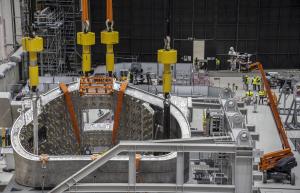Another day, another sector
"Construction work packages," which detail the succession of individual tasks to be performed for each and every ITER assembly activity, read like a preflight check list: Upper counterweight? Installed. Lashing lines? Installed. Metrology diagnostics? Completed. Shim plates? Installed. Stability blocks? All in place... The sequence might not end with the words "Takeoff!" or "Ignition!" resounding in the public address system. But somewhere, among the dozen people involved in the operation, someone is giving the "Go!" and a massive component slowly, almost imperceptibly, begins its ascent.
For the second time in less than a year, a 40° vacuum vessel sector has entered the sub-assembly sequence. The first activity was performed on Thursday 2 December with the lifting of the 440-tonne component from the work platform into the upending tool. The transition from horizontal to vertical by way of a 90° mid-air tilt is planned in the coming days and the docking in the sub-assembly tool (SSAT1) the following week. Operations similar to those performed since April 2021 in the adjacent tool (SSAT2) will follow and in a few months time a second sub-assembly, or "module," will be ready for installation in the tokamak pit.
Lessons learned from the lift of the first sector, in March 2021, resulted in "a better understanding of the fitting operation of the component into the upending tool," says Alex Martin, head of the ITER Vacuum Vessel Section. "We realized we could have a smoother process by dismantling some sub-components prior to the lifting and reinstalling them afterwards before the upending."
One of the challenges of lifting and positioning such a heavy and contorted component lies in determining its precise centre of gravity and adjusting the rigging accordingly. The fine-tuning of the system is performed by four hydraulic "sync hoists" attached to a pair of load-balancing beams suspended to the crane hooks.
"Once the load is perfectly balanced, we need to ensure that the sector and its lifting frame will be precisely oriented in the direction we need during the upending movement. For that, a bit of reverse engineering is required, like the shimming of the interface components between lifting frame and sector," says Martin.
With the success of the second vacuum vessel lift operation part one, the teams are growing more confident. "At the end of the day," says Martin, "it just felt like ... a normal work day."



